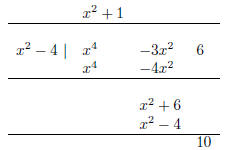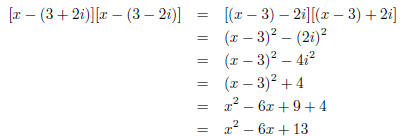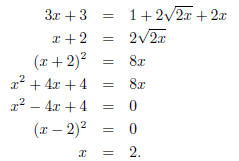1. A function f is defined by the rule f(x) = −7x2 + bx +
c, but we do not know
what the values b and c are . Select the correct statement from the four
statements
below:
(1) The function has both a minimum and a maximum
(2) The function has a minimum but no maximum
(3) The function has a maximum but no minimum
(4) The function has neither maximum nor minimum
The leading coeffient is negative so the graph opens downward and has a maximum.
It has no minimum.
2. Write each quadratic function in the form y = a(x − h)2 + k
(1) y = 2x2 − 12x + 22
Use the method of completing the square:
y = 2x2 − 12x + 22
= 2(x2 − 6x) + 22
= 2(x2 − 6x + 9 − 9) + 22
= 2(x2 − 6x + 9) − 18 + 22
= 2(x − 3)2 + 4
(2) y = −3x2 + 6x − 3
Complete the square:
y = −3(x2 − 2x + 1)
= −3(x − 1)2
3. Find the vertex of each of the following quadratic functions:
(a) f(x) = −3(x − 5)2 + 7
The vertex is at (5, 7).
(b) f(x) = 3x22 − 12x + 1
Complete the square:
f(x) = 3(x2 − 4x) + 1
= 3(x2− 4x + 4 − 4) + 1
= 3(x2 − 4x + 4) − 12 + 1
= 3(x − 2)2 − 11
The vertex is at (2,−11).
3. Let f(x) = −3x2 − 9x + 4. Find the range of this function, the maximum or
minimum value of the function, and identify the intervals on which the function
is
increasing or decreasing.
Complete the square:

We now observe that this is a parabola with maximum at
 ; the range of
; the range of
the function is  , the function is increasing
on
, the function is increasing
on  , and decreasing
, and decreasing
on  .
.
4. Solve the inequality  .
.
This quadratic factors as
(x + 5)(x + 3)
so it has roots at x = −5 and x = −3. The parabola opens upward, so its graph
will
be below the x axis between the two roots . Therefore the solution set is
[−5,−3].
5. Solve the inequality .
.
This is the same quadratic as in the previous problem . Therefore, the graph will
be above the x axis on the intervals  and
and
 .
.
6. Mike wants to wants to enclose a rectangular area for his rabbits alongside
his
large barn using 30 feet of fencing. What dimensions will maximize the area
fenced
if the barn is used as one side of the rectangle?
Let w be the width and L be the length. Then
2w + L = 30,
and the area is given by wL = w(30 − 2w). The area is a quadratic with zeros at
w = 0 and w = 15.. That means that the vertex of the parabola and hence its
maximum occurs at the midpoint between the zeros, which is w =15/2. The length
L = 30 − 2(15/2) = 15.
7. Find the quotient and the remainder when x4 − 3x2 + 6 is divided by x2 − 4.

8. Use synthetic division to find the quotient and remainder when −3x3 + 5x2 + 1
is divided by x + 5.

The quotient is −3x2 + 20x − 100, and the remainder is 501.
9. Use synthetic division to evaluate the value g(−2) when g(x) = x3 − 7x + 2.

10. Use the rational zero theorem to find all possible rational zeros for the
polynomial
2x3 − 5x2 − 4x + 3.
All possible rational zeros are all possible factors of 3 divided by all
possible factors
of 2. They are

11. Find all real and imaginary zeros of the polynomial w4 + w3 − w2 + w − 2.
By the rational zeros theorem, the possible roots are
±1,±2.
Using synthetic division

Use synthentic division a second time:

The quotient is now x2 + 1, which has roots ±i. Therefore, all roots are 1,−2,±i.
12. Find the product by multiplying:
(1) [x − (3 + 2i)][x − (3 − 2i)]
Use the difference of two squares formula to simplifty the multiplication :


13. If y varies directly as x, and y = 9 when x = 2, what is y when x = −3?
Let y = kx. Then 9 = k(2), so k =9/2. This means that y =9/2 x. When x = −3, we
have y = .
.
14. Find a polynomial with real coefficients that has the given roots:
(a) 4 + i
By the conjugate pair theorem, a polynomial that has 4 + i as a root
must also have 4 − i as a root. One such polynomial is
(x − [4 + i])(x − [4 − i]).
Using the difference of two squares:

(b) 3, 1 − i.
By the conjugate pairs theorem, such a polynomial must have 1+i as a
root. One such a polynomial is
(x − 3)(x − [1 − i])(x − [1 + i]).
Again, we can multiply this out with the aid of the difference of two
squares formula:

15. Solve the equation

Square both sides, rearrange, and square both sides again to get rid of
radicals :

16. Solve the equation (x2 + x)2 − 8(x2 + x) + 12 = 0.
Put u = x2 + x. Then
u2 − 8u + 12 = 0
which factors as
(u − 6)(u − 2) = 0.
This in turn leads to
u = 6 and u = 2
so that we have the two equations
x2 + x = 6 and x2 + x = 2.
Solving these last two quadratic equations by factoring , we see that the
solutions
are
x = −3, x = 2, x = −2, x = 1.
17. Solve the equation 
Put u = x1/3. Then the equation becomes
u2 − 9u + 8 = 0
which factors as
(u − 8)(u − 1) = 0
giving answers of
u = 8 and u = 1.
This means that x1/3 = 8, so that x = 83 = 512. It also means that
x1/3 = 1, so
that x = 1. The answers are x = 1 and x = 512.
18. Solve the equation |x2 − 6| = 5x
Either x2 − 6 = 5x or x2 − 6 = −5x.
We get
x2 − 6 = 5x
x2 − 5x − 6 = 0
(x − 6)(x + 1) = 0
so that x = 6 or x = −1. We also have
x2 − 6 = −5x
x2 + 5x − 6 = 0
(x + 6)(x − 1) = 0
so that x = −6 or x = 1. Thus the answers are x = 6,−6, 1,−1..



